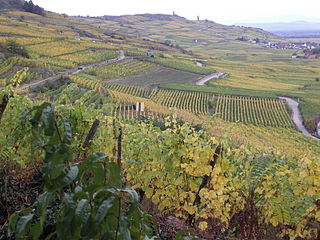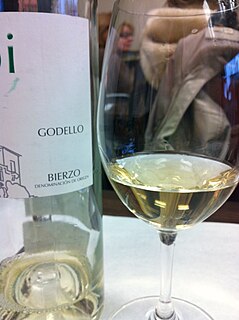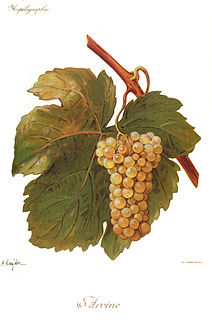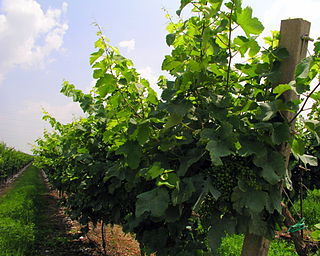Related Research Articles

Syrah, also known as Shiraz, is a dark-skinned grape variety grown throughout the world and used primarily to produce red wine. In 1999, Syrah was found to be the offspring of two obscure grapes from southeastern France, Dureza and Mondeuse Blanche. Syrah should not be confused with Petite Sirah, a cross of Syrah with Peloursin dating from 1880.

Alsace wine or Alsatian wine is produced in the Alsace region in France and is primarily white wine. Because of its Germanic influence, it is the only Appellation d'Origine Contrôlée region in France to produce mostly varietal wines, typically from similar grape varieties to those used in German wine. Along with Austria and Germany, it produces some of the most noted dry Rieslings in the world as well as highly aromatic Gewürztraminer wines. Wines are produced under three different AOCs: Alsace AOC for white, rosé and red wines, Alsace Grand Cru AOC for white wines from certain classified vineyards and Crémant d'Alsace AOC for sparkling wines. Both dry and sweet white wines are produced.

Müller-Thurgau is a white grape variety which was created by Hermann Müller from the Swiss Canton of Thurgau in 1882 at the Geisenheim Grape Breeding Institute in Germany. It is a crossing of Riesling with Madeleine Royale. It is used to make white wine in Germany, Austria, Northern Italy, Hungary, England, Australia, the Czech Republic, Slovakia, Slovenia, New Zealand, Canada, the United States, Belgium and Japan. There are around 22,201 hectares ) cultivated worldwide, which makes Müller-Thurgau the most widely planted of the so-called "new breeds" of grape varieties created since the late 19th century. Although plantings have decreased significantly since the 1980s, as of 2019 it was still Germany's second most planted variety at 11,400 hectares and 11.4% of the total vineyard surface. In 2007, the 125th anniversary was celebrated at the Geisenheim Grape Breeding Institute. Müller-Thurgau is also known as Rivaner, Riesling x Sylvaner, Riesling-Sylvaner, Rizvanec (Slovenia) and Rizlingszilváni (Hungary).

Bourboulenc is a white wine grape variety primarily grown in southern France. The variety is found in the regions Southern Rhône, Provence and Languedoc.

Le Comité Interprofessionnel du vin de Champagne (CIVC) is an organisation grouping the actors of the Champagne production and trade - growers, cooperatives and merchants - under the direction of the government.

Godello is a white variety of wine grape grown in northwestern Spain, in particular in Galicia. The Gouveio found in northern Portugal is thought to be the same grape variety.

Swiss wine is produced from nearly 15,000 hectares of vineyards, and the wines are mainly produced in the west and in the south of Switzerland, in the cantons of Geneva, Neuchâtel, Ticino, Valais and Vaud. White grape varieties are grown on 43% of the country's vineyard area, and red grape varieties on 57%.

Picardan or Picardan blanc is a white wine grape which is one of 13 permitted blending grapes within the Châteauneuf-du-Pape AOC in Rhône wine region in France, although very little planted. The Vitis International Variety Catalogue previously listed Oeillade blanche as the primary name of the variety, but now identifies Araignan as the primary name. However, since the variety is practically unknown for any other use than the Châteauneuf-du-Pape blend, it most commonly goes under the name used for it in that appellation.
Courbu is the name of three different, but related varieties of wine grapes primarily found in South West France. All are Vitis vinifera grapes. The name Courbu, without suffix, can refer to both Petit Courbu and Courbu blanc, and not all sources differ between the two.

Amigne is a white Swiss wine grape planted primarily in the Valais region, with most of the plantations in Vetroz. Total Swiss plantations of the variety in 2009 stood at 43 hectares.

Petite Arvine is a white wine grape planted in the Valais region of Switzerland. Total Swiss plantations of the variety in 2009 stood at 154 hectares.
Humagne Blanche or Humagne is a white Swiss wine grape planted primarily in the Valais region. The total Swiss plantations of the variety in 2009 stood at 30 hectares.
Mammolo is a red Italian wine grape that is planted primarily in Tuscany. While its use has been diminishing, Mammolo was historically included in the blended Sangiovese-based wines of Chianti where it contributed a distinctive violet or mammole aroma. In addition to small plantings in the Chianti zone, Mammolo can be found in the Vino Nobile di Montepulciano region of Tuscany and in scattered vineyards throughout Central Italy.
Gamaret is a variety of red wine grape. It was created by André Jaquinet at Station Fédérale de Recherches en Production Végétale de Changins in 1970 by crossing Gamay and Reichensteiner. Gamaret was developed for cultivation in French Switzerland, and is a full sibling of Garanoir, which was intended for the German part of the country.

Garanoir is a variety of red wine grape. It was created by André Jaquinet and Dominique Maigre at Station Fédérale de Recherches en Production Végétale de Changins in 1970 by crossing Gamay and Reichensteiner. Garanoir was developed for cultivation in German Switzerland, and is a full sibling of Gamaret, which was intended for the French part of the country.
Rouge du Pays, also known as Cornalin du Valais or Cornalin, is a variety of red wine grape. It is primarily grown in the Valais region in Switzerland, where it is often called Cornalin, and the total Swiss plantations of the variety in 2009 stood at 116 hectares. It produces deep-coloured wines that typically need aging, and is something of a speciality of Valais.
Humagne may refer to two wine grape varieties from the Valais region of Switzerland:

Glera, also known as Prosecco, is a white variety of grape of Slovenian origin, which was brought to the village of Prosecco from the Karst region. The variety was formerly mostly referred to as Prosecco, but in the EU was renamed "Glera" in 2009 to make room for the protection of "Prosecco" as the name of a geographically-protected wine.

Petit Rouge is a red Italian wine grape variety that ampelographers believe is indigenous to the Valle d'Aosta region of northwest Italy. However, there is some confusion about whether Petit Rouge is the same variety as the red Swiss wine grape Rouge de Valais.

Prié blanc is a white Italian wine grape variety that is grown almost exclusively in the Valle d'Aosta DOC of northwest Italy. The Valle d'Aosta varietal wine Blanc de Morgex et de La Salle is made from Prié blanc grapes.
References
- 1 2 3 Cornalin d'Aoste Archived 2012-03-23 at the Wayback Machine , Vitis International Variety Catalogue, accessed on June 20, 2010
- 1 2 Jancis Robinson, ed. (2006). "Cornalin d'Aoste". Oxford Companion to Wine (Third ed.). Oxford: Oxford University Press. p. 203. ISBN 0-19-860990-6.
- ↑ Office fédéral de l’agriculture OFAG: Das Weinjahr 2009 / L'année d'viticole 2009 Archived July 7, 2011, at the Wayback Machine
- 1 2 Jancis Robinson, ed. (2006). "Humagne Rouge". Oxford Companion to Wine (Third ed.). Oxford: Oxford University Press. p. 347. ISBN 0-19-860990-6.